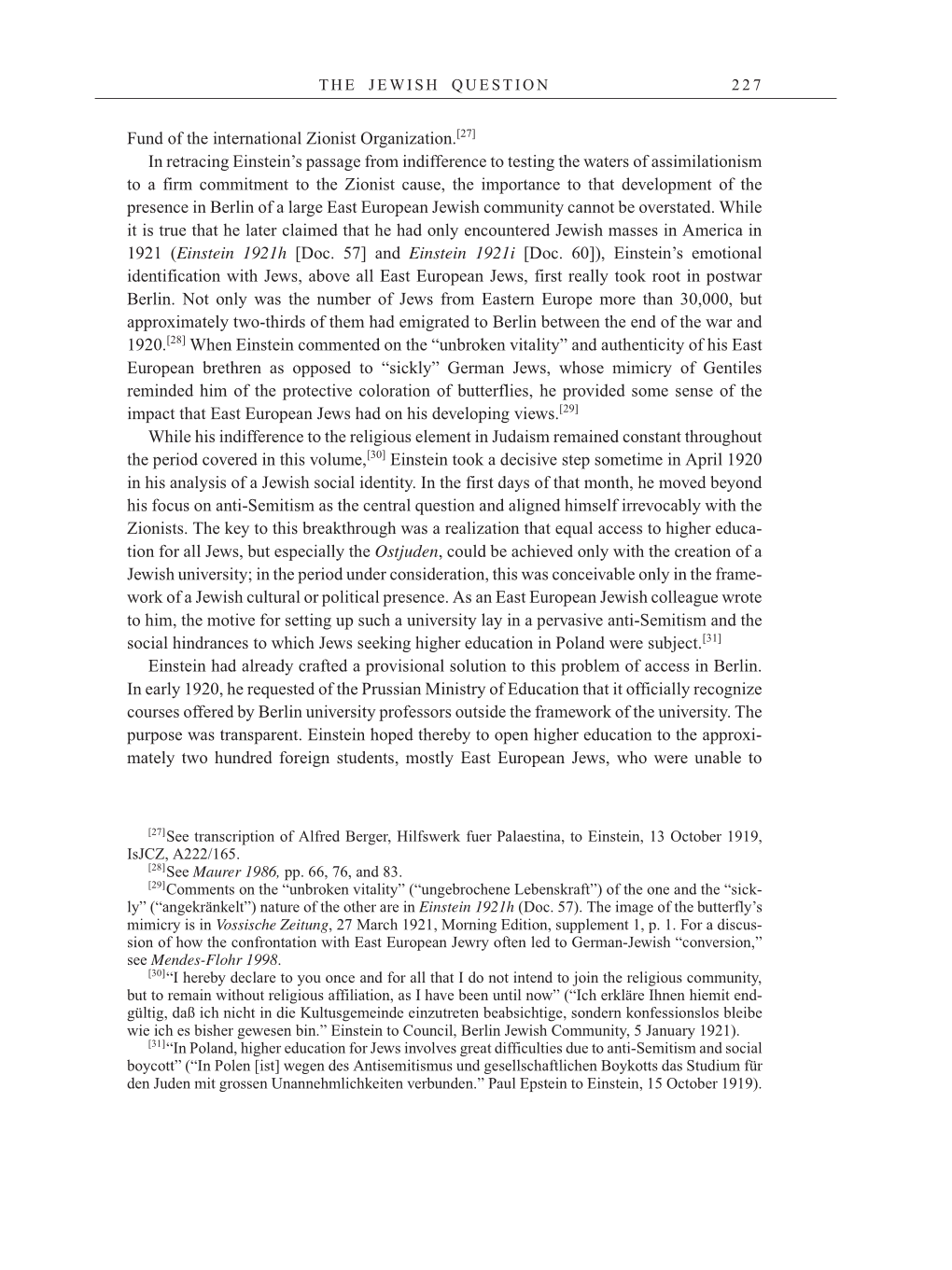T H E J E W I S H QU E S T I O N 2 2 7
Fund of the international Zionist
Organization.[27]
In retracing Einstein’s passage from indifference to testing the waters of assimilationism
to a firm commitment to the Zionist cause, the importance to that development of the
presence in Berlin of a large East European Jewish community cannot be overstated. While
it is true that he later claimed that he had only encountered Jewish masses in America in
1921 (Einstein 1921h [Doc. 57] and Einstein 1921i [Doc. 60]), Einstein’s emotional
identification with Jews, above all East European Jews, first really took root in postwar
Berlin. Not only was the number of Jews from Eastern Europe more than 30,000, but
approximately two-thirds of them had emigrated to Berlin between the end of the war and
1920.[28]
When Einstein commented on the “unbroken vitality” and authenticity of his East
European brethren as opposed to “sickly” German Jews, whose mimicry of Gentiles
reminded him of the protective coloration of butterflies, he provided some sense of the
impact that East European Jews had on his developing
views.[29]
While his indifference to the religious element in Judaism remained constant throughout
the period covered in this
volume,[30]
Einstein took a decisive step sometime in April 1920
in his analysis of a Jewish social identity. In the first days of that month, he moved beyond
his focus on anti-Semitism as the central question and aligned himself irrevocably with the
Zionists. The key to this breakthrough was a realization that equal access to higher educa-
tion for all Jews, but especially the Ostjuden, could be achieved only with the creation of a
Jewish university; in the period under consideration, this was conceivable only in the frame-
work of a Jewish cultural or political presence. As an East European Jewish colleague wrote
to him, the motive for setting up such a university lay in a pervasive anti-Semitism and the
social hindrances to which Jews seeking higher education in Poland were
subject.[31]
Einstein had already crafted a provisional solution to this problem of access in Berlin.
In early 1920, he requested of the Prussian Ministry of Education that it officially recognize
courses offered by Berlin university professors outside the framework of the university. The
purpose was transparent. Einstein hoped thereby to open higher education to the approxi-
mately two hundred foreign students, mostly East European Jews, who were unable to
[27]See transcription of Alfred Berger, Hilfswerk fuer Palaestina, to Einstein, 13 October 1919,
IsJCZ, A222/165.
[28]See Maurer 1986, pp. 66, 76, and 83.
[29]Comments on the “unbroken vitality” (“ungebrochene Lebenskraft”) of the one and the “sick-
ly” (“angekränkelt”) nature of the other are in Einstein 1921h (Doc. 57). The image of the butterfly’s
mimicry is in Vossische Zeitung, 27 March 1921, Morning Edition, supplement 1, p. 1. For a discus-
sion of how the confrontation with East European Jewry often led to German-Jewish “conversion,”
see Mendes-Flohr 1998.
[30]“I hereby declare to you once and for all that I do not intend to join the religious community,
but to remain without religious affiliation, as I have been until now” (“Ich erkläre Ihnen hiemit end-
gültig, daß ich nicht in die Kultusgemeinde einzutreten beabsichtige, sondern konfessionslos bleibe
wie ich es bisher gewesen bin.” Einstein to Council, Berlin Jewish Community, 5 January 1921).
[31]“In Poland, higher education for Jews involves great difficulties due to anti-Semitism and social
boycott” (“In Polen [ist] wegen des Antisemitismus und gesellschaftlichen Boykotts das Studium für
den Juden mit grossen Unannehmlichkeiten verbunden.” Paul Epstein to Einstein, 15 October 1919).
